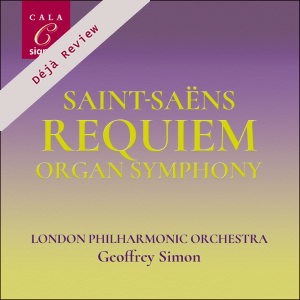
Déjà Review: this review was first published in June 2007 and the recording is still available.
Camille Saint-Saëns (1835-1921)
Overture to La Princesse Jaune Op.30 (1872)
Requiem Op.54 (1878)
Symphony No.3 in C minor Organ Symphony (1886)
Tinuke Olafimihan (soprano), Catherine Wyn-Rogers (contralto), Anthony Roden (tenor), Simon Kirkbride (bass)
James O’Donnell (organ)
The Hertfordshire, Harlow and East London Choruses
London Philharmonic Orchestra/Geoffrey Simon
rec. 1993, All Hallows Church, Gospel Oak, London
Originally reviewed as Cala CACDS4032
Cala Signum SIGCD2163 [78]
Cala and Saint-Saëns collectors will remember the two CDs issued by the company in the mid-1990s. They were recorded in 1993 and 1994 and appeared on Cala CACD 1015 and 1016. I’ve dealt elsewhere with the pot-pourri-ish disc that contains the fabulous Africa.
The disc under review conjoins the little-heard Requiem with the often-heard Third Symphony. As an opener we also have the atmospheric Overture to La Princesse Jaune. It’s an engaging work, spiced with Japanoiserie and neatly performed by the L.P.O. – fans of Offenbach will recognise a kindred spirit.The Organ Symphony hardly lacks for adherents on disc. James O’Donnell is the organist and for once the organ doesn’t sound “phoned in” from an unsympathetic acoustic. The performance is precise and spruce, though not one that necessarily radiates the alpha and omega of glamour. The weight of interest for the disc – and I have to say my own critical enthusiasm – will therefore be felt more for the choral work, and not merely because of its rarity. It gets a good performance too.
He wrote it within the space of eight days in 1878. It prefigures the Requiem by Fauré in its simplicity and entreatingly devotional setting. And it manages to avoid bombast and grandiloquent orchestration, instead pursuing the more benevolent waters of consolation. That said after the opening Kyrie the Dies Irae is powerfully scored for four trombones with some incisive organ interjections as well – so this is hardly a supine work either. Rhythmic vivacity is underlined in the Rex Tremendae which is a vital and energetic movement somewhat dampened by the slightly mushy sound. This was a drawback on the original release and the SACD format has not benefited the clarity or precision of the choral entries for example. All three choirs sing well but the slight problems remain. The Requiem also grants moments of instrumental felicity – the delicacy of the Oro Supplex is a particular case in point. The soloists – all excellent – coil and twist their way here and prove a fine quartet throughout the Requiem’s thirty-five minute length. In the Hostias we find Saint-Saëns fusing classical and romantic models to greatest effect – and the resulting verdant simplicity is heartening and uplifting and sounds explicitly to have influenced Fauré. Similarly the grave lyricism of the Agnus Dei acts as a consolatory ending.
This is certainly a worthwhile restoration. I’ve made something of the recording’s lack of optimum choral focus in the Requiem but that shouldn’t deter those who want to investigate this unusual and rare work.
Jonathan Woolf
Buying this recording via a link below generates revenue for MWI, which helps the site remain free




















